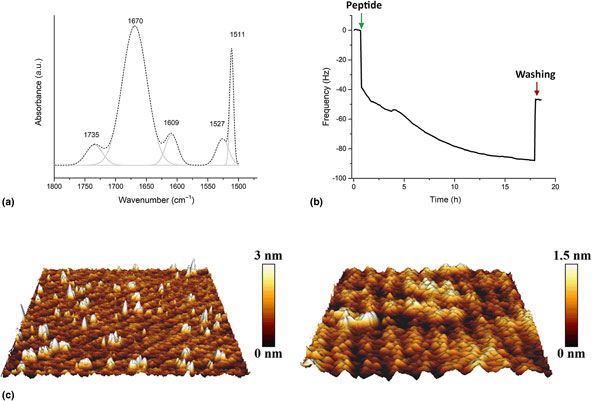Crossref Citations
This article has been cited by the following publications. This list is generated based on data provided by
Crossref.
Friedlander, Alon
Nir, Sivan
Reches, Meital
and
Shemesh, Moshe
2019.
Preventing Biofilm Formation by Dairy-Associated Bacteria Using Peptide-Coated Surfaces.
Frontiers in Microbiology,
Vol. 10,
Issue. ,
Vagos, Márcia R.
Gomes, Marisa
Moreira, Joana M. R.
Soares, Olívia S. G. P.
Pereira, Manuel F. R.
and
Mergulhão, Filipe J.
2020.
Carbon Nanotube/Poly(dimethylsiloxane) Composite Materials to Reduce Bacterial Adhesion.
Antibiotics,
Vol. 9,
Issue. 8,
p.
434.
Ya’ari, Sarah
Halperin-Sternfeld, Michal
Rosin, Boris
and
Adler-Abramovich, Lihi
2020.
Surface Modification by Nano-Structures Reduces Viable Bacterial Biofilm in Aerobic and Anaerobic Environments.
International Journal of Molecular Sciences,
Vol. 21,
Issue. 19,
p.
7370.
Dolid, Alona
Gomes, Luciana C.
Mergulhão, Filipe J.
and
Reches, Meital
2020.
Combining chemistry and topography to fight biofilm formation: Fabrication of micropatterned surfaces with a peptide-based coating.
Colloids and Surfaces B: Biointerfaces,
Vol. 196,
Issue. ,
p.
111365.
Alves, Patrícia
Moreira, Joana Maria
Miranda, João Mário
and
Mergulhão, Filipe José
2020.
Analysing the Initial Bacterial Adhesion to Evaluate the Performance of Antifouling Surfaces.
Antibiotics,
Vol. 9,
Issue. 7,
p.
421.
Senevirathne, S. W. M. A. I.
Hasan, J.
Mathew, A.
Woodruff, M.
and
Yarlagadda, P. K. D. V.
2021.
Bactericidal efficiency of micro- and nanostructured surfaces: a critical perspective.
RSC Advances,
Vol. 11,
Issue. 3,
p.
1883.
Gomes, Luciana C.
and
Mergulhão, Filipe J. M.
2021.
A Selection of Platforms to Evaluate Surface Adhesion and Biofilm Formation in Controlled Hydrodynamic Conditions.
Microorganisms,
Vol. 9,
Issue. 9,
p.
1993.
Carvalho, Fábio M.
Teixeira-Santos, Rita
Mergulhão, Filipe J. M.
and
Gomes, Luciana C.
2021.
Effect of Lactobacillus plantarum Biofilms on the Adhesion of Escherichia coli to Urinary Tract Devices.
Antibiotics,
Vol. 10,
Issue. 8,
p.
966.
Gomes, Luciana C.
Teixeira-Santos, Rita
Romeu, Maria J.
and
Mergulhão, Filipe J.
2022.
Urinary Stents.
p.
225.
Gomes, Marisa
Gomes, Luciana C.
Teixeira-Santos, Rita
Pereira, Manuel F.R.
Soares, Olívia S.G.P.
and
Mergulhão, Filipe J.
2022.
Carbon nanotube-based surfaces: Effect on the inhibition of single- and dual-species biofilms of Escherichia coli and Enterococcus faecalis.
Results in Surfaces and Interfaces,
Vol. 9,
Issue. ,
p.
100090.
Domingues, Beatriz
Pacheco, Margarida
de la Cruz, Julia E.
Carmagnola, Irene
Teixeira‐Santos, Rita
Laurenti, Marco
Can, Fusun
Bohinc, Klemen
Moutinho, Fabíola
Silva, Joana M.
Aroso, Ivo M.
Lima, Estêvão
Reis, Rui L.
Ciardelli, Gianluca
Cauda, Valentina
Mergulhão, Filipe J.
Gálvez, Federico S.
and
Barros, Alexandre A.
2022.
Future Directions for Ureteral Stent Technology: From Bench to the Market.
Advanced Therapeutics,
Vol. 5,
Issue. 1,
Amado, Pedro
Zheng, Shaokai
Lange, Dirk
Carugo, Dario
Waters, Sarah L.
Obrist, Dominik
Burkhard, Fiona
and
Clavica, Francesco
2024.
The interplay between bacterial biofilms, encrustation, and wall shear stress in ureteral stents: a review across scales.
Frontiers in Urology,
Vol. 3,
Issue. ,






